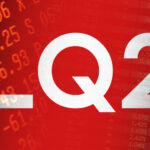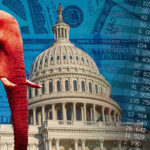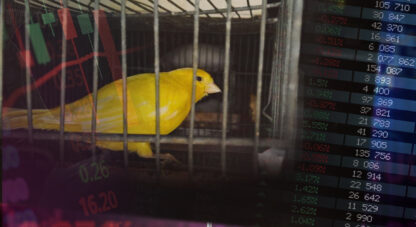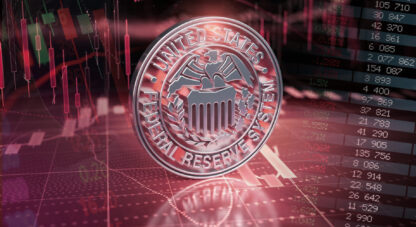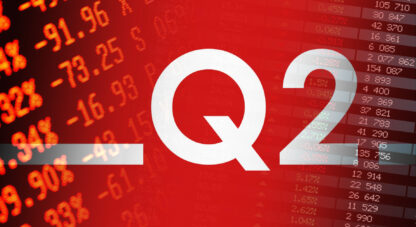Equities rallied to begin the week. With Syrian missile strikes more limited than feared and no military response from Russia, there was immediate impetus to unwind hedges. That it was option expiration week ensured plenty of firepower. The S&P500 had rallied 2.3% at Wednesday’s trading high, before a resumption of selling cut the gain for the week to 0.5%.
WTI crude dropped $1.17 in Monday’s trading, though selling was short-lived. Crude gained $1.01 for the week to $68.40, trading to the high since December 2014. WTI is now up a rather inflationary 13% y-t-d. The President’s Friday morning tweet – “Looks like OPEC is at it again. With record amounts of Oil all over the place, including the fully loaded ships at sea, Oil prices are artificially Very High! No good and will not be accepted!” – generated media attention but only brief selling pressure. The market seems to think it knows more about crude supply dynamics than the Commander and Chief.
The GSCI Commodities Index rose another 1.2% this week (up 7.1% y-t-d), also to the high since December 2014. It wasn’t only energy driving commodity gains. Silver rose 3.0% this week, with Palladium up 4.2%, Aluminum 8.1%, Zinc 3.7%, Nickel 6.4%, Tin 3.2% and Copper 2.8%.
Trade frictions, Middle East instability and general geopolitical uncertainty add up to mounting inflation concerns. The 10-year TIPS breakeven rate (implied inflation rate calculated by subtracting the 10-year TIP yield from the 10-year Treasury yield) rose four bps this week to 2.18%, the high since August 2014. It’s worth noting that the breakeven rate bottomed at 1.26% in February 2016. It rallied to 2.07% by early-2017 before settling back to 1.68% near mid-year – and has been on a reasonably steady ascent now for nine months.
Ten-year Treasury yields rose 13 bps this week to 2.96%, surpassing the February 21st level to the high going back to January 2014. If 10-year Treasuries surpass 3.0% next week, it will mark the highest yield since July 2011. Two-year yields jumped nine bps to 2.45%, the high going back to August 2008. Generating surprisingly little attention, Benchmark MBS yields surged 14 bps this week to 3.66% (up 66bps y-t-d!), the high all the way back to September 2013. Expect more discussion about mortgage convexity.
Notably, 10-year Treasury yields rose eight bps during Thursday and Friday trading, despite a 1.4% fall in the S&P500. The safe haven status of Treasuries is anything but iron clad these days. Treasuries did, however, outperform investment-grade corporates. The iShares investment-grade ETF (LQD) fell 1.27% this week – most of the decline coming Wednesday through Friday – to trade below March lows. Sell Treasuries to hedge mortgage and corporate interest-rate risk. Between new issuance and hedging related selling, that’s a supply glut that risks a bout of market indigestion.
Yet this week’s jump in yields was not isolated to U.S. fixed-income. Key emerging bond markets were under pressure, particularly during Friday’s session. Mexico saw its 10-year (dollar) yields jump 17 bps this week to 4.31%. Mexican bond yields are now up 70bps y-t-d and close to breaking out to highs going back to 2011. Brazilian bond (dollar) yields rose seven bps (to 4.99%), Peru’s 15 bps, Colombia’s nine bps, and Indonesia’s 12 bps. Indonesia saw its local currency 10-year yields jump 20 bps to 6.74%, and India’s local bond yields surged 21 bps to 7.74%.
Friday EM trading was notable. Currencies came under pressure, as the South African rand dropped 1.15%, the Colombian peso 1.0%, the Turkish lira 0.85%, the Russian ruble 0.8% and the Brazilian real 0.7%. For the week, the Mexican peso dropped 2.6%, the Colombian peso 1.8% and the Indian rupee 1.4%. Combining currency and bond losses, there was some pain this week in key emerging markets. In equities, the Shanghai Composite dropped 1.5% Friday, increasing losses for the week to 2.8% (down 7.1% y-t-d). EM inflows have been unrelenting in the face of a lengthening list of issues. Why do I sense these flows are about to reverse?
April 18 – Financial Times (Peter Wells): “The chances of the Federal Reserve delivering four interest rates in 2018 have ballooned in recent days. There is a 35.3% chance the US central bank will deliver three more rate rises this year, following its 0.25 percentage lift in March…, which is the highest probability in the history of the contract. As such, the chance of the Fed delivering at least three interest rate rises this year is sitting at 82%, also a contract-era high.”
It’s a far cry from “slamming on the brakes,” yet the Fed is finally feeling some heat to get short-term rates up to a more reasonable level. A novel idea was offered by Dallas Federal Reserve Bank President Robert Kaplan: “I don’t have a problem with being restrictive.” As notably, the doves have really come around. Federal Reserve Bank of Minneapolis President Neel Kashkari: “I think it’s likely that the fiscal actions that have been taken are going to on the margin help us achieve our inflation target. I was much more skeptical… It now seems much more likely that we are going to actually achieve our inflation target in the near future…” And from Governor Lael Brainard: “My anticipation is that the outlook is for continued, solid growth. The outlook looks consistent to me for continued gradual increases in the federal funds rate.”
Imagining a murkier inflation outlook doesn’t come easily. The global boom has decent momentum, although lurking financial fragilities could rather abruptly haunt economic prospects. Tariffs, protectionism and trade wars have the potential for consequential pricing impacts. There is, as well, significant ramifications for the global economy in the event trade disputes really heat up. And let us not forget an extraordinarily uncertain geopolitical backdrop, with myriad potential consequences for inflation and growth. Last but not least, there’s the great uncertainty associated with myriad interdependent global Bubbles.
One thing we know with certainty: the world has added tremendous amounts of debt since the last debt crisis. And debt is poised to continue rising rapidly until sober markets impose some discipline on profligate borrowers. This is a momentous festering issue that will come to a head at some point. Ten-years of ultra-loose global finance destroyed discipline – by borrowers and lenders alike. “Deficits don’t matter.” In the markets, the view holds that central banks won’t tolerate a problematic backup in market yields. So, as central bankers gaze submissively from the sidelines, governments just keep issuing debt and markets keep buying it.
April 18 – Bloomberg (Andrew Mayeda): “The world’s debt load has ballooned to a record $164 trillion, a trend that could make it harder for countries to respond to the next recession and pay off debts if financing conditions tighten, the International Monetary Fund said. Global public and private debt swelled to 225% of global gross domestic product in 2016, the last year for which the IMF provided figures, the fund said… in its semi-annual Fiscal Monitor report. The previous peak was in 2009, according to the… fund. ‘One hundred and sixty-four trillion is a huge number,’ Vitor Gaspar, head of the IMF’s fiscal affairs department, said… ‘When we talk about the risks looming on the horizon, one of the risks has to do with the high level of public and private debt.’”
For posterity, I’ve pulled a few paragraphs from the IMF’s most recent Fiscal Monitor report:
“At $164 trillion-equivalent to 225% of global GDP-global debt continues to hit new record highs almost a decade after the collapse of Lehman Brothers. Compared with the previous peak in 2009, the world is now 12% of GDP deeper in debt, reflecting a pickup in both public and nonfinancial private sector debt after a short hiatus. All income groups have experienced increases in total debt but, by far, emerging market economies are in the lead. Only three countries (China, Japan, United States) account for more than half of global debt -significantly greater than their share of global output…
“A large number of countries currently have a high debt-to-GDP ratio, as suggested by critical thresholds identified in the IMF’s debt sustainability analysis. In 2017, more than one-third of advanced economies had debt above 85% of GDP, three times more countries than in 2000. One-fifth of emerging market and middle-income economies had debt above 70% of GDP in 2017, similar to levels in the early 2000s in the aftermath of the Asian financial crisis. One-fifth of low-income developing countries now have debt above 60% of GDP, compared with almost none in 2012.”
“From a longer-term perspective, global indebtedness has been driven by private sector debt-which has almost tripled since 1950. For almost six decades, advanced economies spearheaded the global leverage cycle, with the debt of the nonfinancial private sector reaching a peak of 170% of GDP in 2009, with little deleveraging since. Emerging market economies, in contrast, are relative newcomers. Their nonfinancial private debt started to accelerate in 2005, overtaking advanced economies as the main force behind global trends by 2009. Private debt ratios doubled in a decade, reaching 120% of GDP by 2016.”
“The ongoing recovery presents a golden opportunity to focus fiscal policy on rebuilding buffers and raising potential growth. Forecasts indicate that economic activity will continue to accelerate, which implies that fiscal stimulus to support demand is no longer a priority in most countries. Governments should avoid the temptation of spending the revenue windfalls during good times. Starting to rebuild buffers now will ensure that policymakers have sufficient fiscal ammunition to respond in case of a downturn and prevent fiscal vulnerabilities themselves from hurting the economy.”
Wishful thinking with respect to “a golden opportunity.” The global government finance Bubble has been fueled by almost a decade of near zero rates, massive central bank monetization and unprecedented amounts of government borrowing. My view holds that myriad global Bubbles have become only more vulnerable to any meaningful tightening of financial conditions. And there are pressing issues that increasingly put the loose financial landscape in jeopardy.
China has belatedly moved to slow system Credit growth. On the surface, it appears they are having some success. Overall Credit expansion has decelerated, mainly on the back of significant regulator pressures over shadow banking. At the same time, mortgage and household lending has accelerated. One can make a case that the overall ongoing expansion of non-productive Credit growth remains highly problematic. Underlying financial fragility continues to worsen. Along with sinking stock prices, China’s interbank lending market this week indicated tightened liquidity conditions. The People’s Bank of China announced Tuesday that it would support lending with lower bank reserve requirements.
April 17 – Wall Street Journal (William A. Galston): “I know that worrying about the deficit and debt is hopelessly retro, but please indulge me for a few minutes. Last week the Congressional Budget Office issued its outlook for the next 10 years. The news was not good. Over the next decade, the annual federal deficit averages $1.2 trillion. It rises from 3.5% of gross domestic product in 2017 to 5.1% in 2027. The national debt, which is driven by annual deficits, rises from $15.7 trillion to $28.7 trillion over the same period, and surges from 78.0% to 96.2% as a share of GDP-the highest mark since just after World War II. These projections have worsened significantly since the CBO’s report last June, and public-policy decisions are the culprit.”
April 18 – Bloomberg (Vincent Del Giudice and Alexandre Tanzi): “Mamma Mia! In five years, the U.S. government is forecast to have a bleaker debt profile than Italy, the perennial poor man of the Group of Seven industrial nations. The U.S. debt-to-GDP ratio is projected widen to 116.9% by 2023 while Italy’s is seen narrowing to 116.6%, according to the latest data from the International Monetary Fund. The U.S. will also place ahead of both Mozambique and Burundi in terms of the weight of its fiscal burden.”
If China’s Bubble doesn’t pose enough risk for global finance, there’s the unfolding fiscal fiasco in Washington. Put on so much debt and you sacrifice flexibility – that’s the case for the U.S., China and globally. Especially for the behemoth importer U.S. economy, tariffs and trade wars risk stronger inflation. There is as well the risk that our foreign creditors might find less appetite for additional bonds and other U.S. financial assets. Then there’s the pressure such egregious late-cycle fiscal stimulus places on the Federal Reserve. For a Fed that is already far behind the curve, the prospect of stimulus-induced economic expansion with heightened inflationary pressures must be unsettling. Long convinced that inflation was dead and buried, doubt is now making some headway.
It’s hard for me to believe there’s not massive leverage throughout U.S. and global fixed-income markets. This historic speculative Bubble was at risk of being pierced back in late-2016. 2017, however, proved to be a year with still enormous ongoing global QE (chiefly BOJ and ECB), rampant Chinese Credit expansion and global inflation dynamics that just didn’t quite attain momentum. Along the way, financial conditions remained extraordinarily loose and markets ever more complacent.
With the bond vigilantes long extinct, an overindulgent Washington embarked on massive tax cut fiscal stimulus. Mission Accomplished. Next on the agenda, trade and China. This week saw 10-year Treasury yields a mere four bps away from the 3.00% bogey. U.S. and emerging bond markets would appear unusually poised for a negative surprise. Things get interesting if the Fed ever ponders whether monetary tightening might be necessary to calm a frazzled bond market. Thinking back, I’ve always been intrigued by how the bond (and derivatives!) market was so caught by surprise in 1994. IO’s and PO’s and such and, of course, ghastly amount of speculative leverage.
For the Week:
The S&P500 added 0.5% (down 0.1% y-t-d), and the Dow increased 0.4% (down 1.0%). The Utilities gained 1.1% (down 4.8%). The Banks rose 0.9% (up 0.6%), and the Broker/Dealers jumped 3.3% (up 10.7%). The Transports jumped 2.0% (down 0.3%). The S&P 400 Midcaps gained 0.9% (unchanged), and the small cap Russell 2000 rose 0.9% (up 1.9%). The Nasdaq100 added 0.6% (up 4.2%). The Semiconductors sank 4.4% (up 1.4%). The Biotechs fell 1.3% (up 8.1%). With bullion down almost $10, the HUI gold index increased 0.4% (down 4.2%).
Three-month Treasury bill rates ended the week at 1.77%. Two-year government yields rose 10 bps to 2.46% (up 57bps y-t-d). Five-year T-note yields gained 13 bps to 2.80% (up 59bps). Ten-year Treasury yields jumped 13 bps to 2.96% (up 55bps). Long bond yields gained 12 bps to 3.15% (up 41bps).
Greek 10-year yields declined five bps to 4.02% (down 5bps y-t-d). Ten-year Portuguese yields were unchanged at 1.66% (down 29bps). Italian 10-year yields slipped two bps to 1.79% (down 24bps). Spain’s 10-year yields rose four bps to 1.28% (down 29bps). German bund yields jumped eight bps to 0.59% (up 16bps). French yields rose seven bps to 0.81% (up 3bps). The French to German 10-year bond spread narrowed one to 22 bps. U.K. 10-year gilt yields gained four bps to 1.48% (up 29bps). U.K.’s FTSE equities index jumped 1.4% (down 4.2%).
Japan’s Nikkei 225 equities index gained 1.8% (down 2.6% y-t-d). Japanese 10-year “JGB” yields added two bps to 0.06% (up 1bp). France’s CAC40 rose 1.8% (up 1.9%). The German DAX equities index gained 0.8% (down 2.9%). Spain’s IBEX 35 equities index rose 1.2% (down 1.6%). Italy’s FTSE MIB index jumped 2.1% (up 9.0%). EM equities were mixed. Brazil’s Bovespa index gained 1.4% (up 12%), while Mexico’s Bolsa declined 0.7% (down 1.9%). South Korea’s Kospi index rose 0.9% (up 0.4%). India’s Sensex equities index increased 0.7% (up 1.1%). China’s Shanghai Exchange dropped 2.8% (down 7.1%). Turkey’s Borsa Istanbul National 100 index rallied 1.2% (down 3.8%). Russia’s MICEX equities recovered 2.6% (up 5.8%).
Investment-grade bond funds saw inflows of $1.535 billion, and junk bond funds posted inflows of $2.971 billion (from Lipper).
Freddie Mac 30-year fixed mortgage rates gained five bps to 4.47% (up 50bps y-o-y). Fifteen-year rates jumped seven bps to 3.94% (up 71bps). Five-year hybrid ARM rates rose six bps to 3.67% (up 57bps). Bankrate’s survey of jumbo mortgage borrowing costs had 30-yr fixed rates up four bps to 4.52% (up 45bps).
Federal Reserve Credit last week expanded $6.4bn to $4.349 TN. Over the past year, Fed Credit contracted $95.1bn, or 2.1%. Fed Credit inflated $1.538 TN, or 55%, over the past 285 weeks. Elsewhere, Fed holdings for foreign owners of Treasury, Agency Debt dropped $13.2bn last week to $3.437 TN. “Custody holdings” were up $231bn y-o-y, or 7.2%.
M2 (narrow) “money” supply declined $11.6bn last week to $13.936 TN. “Narrow money” gained $528bn, or 3.9%, over the past year. For the week, Currency increased $2.6bn. Total Checkable Deposits rose $8.7bn, while savings Deposits fell $29bn. Small Time Deposits gained $3.4bn. Retail Money Funds added $2.8bn.
Total money market fund assets sank $33.4bn to $2.794 TN. Money Funds gained $167bn y-o-y, or 6.4%.
Total Commercial Paper rose $7.0bn to $1.065 TN. CP gained $90bn y-o-y, or 9.2%.
Currency Watch:
April 19 – Financial Times (Emma Dunkley): “Hong Kong’s de facto central bank indicated there would be more currency intervention to come, after the monetary authority bought more than HK$51bn to support the Hong Kong dollar over the past week. The Hong Kong Monetary Authority had stepped in 13 times within a week by Thursday morning, using its reserves to sell US$6.54bn and buying Hong Kong dollars to prop up the local currency, after it slumped to its weakest level since 2005… The HKMA is required to support the peg if the Hong Kong dollar slips to the edges of the band…”
The U.S. dollar index gained 0.6% to 90.316 (down 2.0% y-t-d). For the week on the upside, the Swedish krona increased 0.3%, the Brazilian real 0.3% and the South Korean won 0.2%. For the week on the downside, the Mexican peso declined 2.6%, the New Zealand dollar 2.2%, the British pound 1.7%, the Swiss franc 1.3%, the Canadian dollar 1.2%, the Australian dollar 1.2%, the Norwegian krone 0.6%, the euro 0.3%, the Singapore dollar 0.3%, the Japanese yen 0.3%, and the South African rand 0.3%. The Chinese renminbi slipped 0.34% versus the dollar this week (up 3.34% y-t-d).
Commodities Watch:
April 19 – Reuters (David Gaffen): “Oil prices on Thursday hit highs not seen since 2014, built on the ongoing drawdowns in global supply and as Saudi Arabia looks to push prices higher, though U.S. crude gave back gains in the afternoon to finish lower. A global oil glut has been virtually eliminated, according to a joint OPEC and non-OPEC technical panel…, thanks in part to an OPEC-led supply cut deal in place since January 2017.”
April 18 – Reuters (Rania El Gamal and Alex Lawler): “Top oil exporter Saudi Arabia would be happy to see crude rise to $80 or even $100 a barrel, three industry sources said, a sign Riyadh will seek no changes to an OPEC supply-cutting deal even though the agreement’s original target is within sight. The Organization of the Petroleum Exporting Countries, Russia and several other producers began to reduce supply in January 2017 in an attempt to erase a glut. They have extended the pact until December 2018 and meet in June to review policy.”
April 19 – CNBC (Jeff Cox): “Threats of a trade war and continued signs of global growth are combining to create myriad opportunities for investors in one long-dormant asset class: commodities. In fact, the geopolitical turbulence and market volatility putting downward pressure on the stock market is working out just fine for the commodities market, which languished for years under slow economic conditions and a general trading malaise. One popular commodities index just hit a 2½-year high, and investors in the space see the trend continuing.”
April 16 – Bloomberg (Mark Burton): “Aluminum extended last week’s record gain, touching the highest in more than six and a half years in London as the market weighed the possibility that United Co. Rusal will be forced to cut production after being shut out of western markets.”
The Goldman Sachs Commodities Index gained 1.2% (up 7.1% y-t-d). Spot Gold slipped 0.7% to $1,336 (up 2.5%). Silver jumped 3.0% to $17.16 (up 0.1%). Crude rose another $1.01 to $68.40 (up 13%). Gasoline gained 1.5% (up 17%), while Natural Gas was little changed (down 7%). Copper jumped 2.8% (down 4%). Wheat fell 2.5% (up 12%). Corn dropped 2.3% (up 10%).
Market Dislocation Watch:
April 18 – Bloomberg (Lu Wang, Elena Popina, and Luke Kawa): “The Cboe Volatility Index is how Wall Street measures anxiety. Lately it’s the gauge’s own plumbing that’s making people nervous. It’s a recurrent claim — the VIX is rigged. It got a fresh airing Wednesday, when the index swung wildly just as derivatives on it were expiring. Billions of dollars are earned or lost as VIX futures settle. The concern is that owners of those wagers are willing to spend a few million to make them pay off. The suspicions are only that, suspicions. Volatility markets are too complex for easy conclusions to be drawn, and reasonable explanations have been offered for the patterns. But strange-looking outcomes have happened enough on VIX settlement day that the debate keeps being revived.”
April 15 – Wall Street Journal (Chelsey Dulaney and Ira Iosebashvili): “The currencies of places as diverse as Russia, Hong Kong and Kazakhstan slid last week, an alarming sign to some investors who worry that the geopolitical volatility affecting U.S. stocks is spreading to other markets. Hong Kong’s dollar hit the lowest level allowed under a more than three-decade-old U.S. dollar-peg agreement, forcing the de facto central bank to step in to defend the currency and stabilize it. Russia’s ruble fell amid increased U.S. sanctions against the country and concern about a U.S. strike on Syria, a decline that also contributed to a fall in Kazakhstan’s tenge.”
Trump Administration Watch:
April 19 – Bloomberg (Saleha Mohsin): “The Treasury Department is considering using an emergency law to curb Chinese investments in sensitive technologies, as the Trump administration looks to punish China for what it sees as violations of American intellectual-property rights. The U.S. government is reviewing the possible use of a law known as the International Emergency Economic Powers Act, said Heath Tarbert, an assistant secretary in the agency’s international affairs office. Under the 1977 law, President Donald Trump could declare a national emergency in response to an ‘unusual and extraordinary threat,’ allowing him to block transactions and seize assets.”
April 18 – Axios (Steve LeVine): “The U.S. is experiencing a revival of Japan syndrome, harking back to the late 1970s when ‘Made in Japan’ abruptly stopped being a source of mirth, Americans began to snap up Toyotas and Nissans in big numbers, and Detroit sank into a profit-and-jobs bloodbath. The big picture: Five years ago, American technologists sneered at China’s Baidu and its new search engine. But ‘they aren’t laughing anymore,’ says Gregory Allen, an AI expert at the Center for a New American Security. ‘Now they are marveling at Baidu’s advances in artificial intelligence.’ Chinese Big Tech is one dimension of a juggernaut that’s collectively terrifying the Trump administration, Silicon Valley and the western foreign policy community. It’s ‘Made in China 2025,’ Beijing’s three-year old game plan for dominating the 10 biggest technologies of the future, such as AI, robotics and electric cars.”
April 17 – New York Times (Raymond Zhong, Paul Mozur and Jack Nicas): “The United States undercut China’s technology ambitions on Tuesday, advancing a new rule that would limit the ability of Chinese telecommunications companies to sell their products in this country. The Federal Communications Commission voted unanimously to move forward with a plan that would prevent federally subsidized telecommunications carriers from using suppliers deemed to pose a risk to American national security. The decision takes direct aim at Huawei, which makes telecommunications network equipment and smartphones, and its main Chinese rival, ZTE…”
April 16 – Reuters (Steve Stecklow, Karen Freifeld and Sijia Jiang): “The United States has banned American firms from selling parts and software to China’s ZTE Corp for seven years, potentially devastating for the telecoms equipment maker and exacerbating tensions between the world’s two largest economies… The U.S. Commerce Department imposed the ban following ZTE’s violation of an agreement on punishing employees that was reached after it was caught illegally shipping U.S. goods to Iran.”
April 19 – Reuters: “China will retaliate if the United States insists on initiating a trade war, China’s ambassador to the United States was quoted as saying… Speaking at an event… Cui Tiankai said any dispute should be worked out through dialogue and a trade war would poison the atmosphere of overall China-U.S. relations.”
April 16 – Reuters (Doina Chiacu, Dan Burns and James Oliphant): “U.S. President Donald Trump accused Russia and China… of devaluing their currencies while the United States raises interest rates, prompting China to accuse the United States of sending confusing messages. ‘Russia and China are playing the Currency Devaluation game as the U.S. keeps raising interest rates. Not acceptable!’ Trump said in a Twitter post.”
April 20 – CNBC (John Melloy): “President Donald Trump blasted the oil-producing cartel OPEC on Twitter on Friday. ‘Looks like OPEC is at it again,’ he wrote. ‘With record amounts of Oil all over the place, including the fully loaded ships at sea, Oil prices are artificially Very High! No good and will not be accepted!’”
April 17 – The Hill (Mike Lillis): “Rep. Steny Hoyer (D-Md.) said… that Democrats would seek to roll back the GOP’s tax-code overhaul if they control the lower chamber next year. Hoyer, the minority whip, said the Democrats would not repeal the tax law in its entirety, citing certain provisions the party supports, such as cuts for the middle class, a reduction in the corporate rate and efforts to encourage companies to repatriate foreign-held dollars into the U.S. economy. But Hoyer said the 21% corporate tax rate adopted in the GOP bill is too low, suggesting that Democrats would raise it.”
April 18 – Wall Street Journal (Greg Ip): “Among President Donald Trump’s most deeply held economic convictions is that trade deficits are bad, yet his signature economic policy-a major tax cut-likely will deepen the trade deficits he abhors for years to come. For now, that’s more a problem of optics than economics, albeit one that may prompt Mr. Trump to dial up trade tensions with other countries. But in the long run wider trade deficits will make Americans poorer. That’s not because foreigners are stealing American jobs, as Mr. Trump often contends. Rather, it’s because Americans will increasingly borrow from foreigners to sustain their standard of living. Paying them back will wipe out a sizable chunk of the tax cut’s benefit.”
April 17 – CNBC (Michelle Fox): “The United States has to make it clear to Russian President Vladimir Putin that there are lines that the U.S. will not allow Russia to cross, former Defense Secretary Leon Panetta told CNBC… ‘There’s no question we’re in a new chapter of the Cold War with Russia,’ Panetta said… ‘There are an awful lot of steps that the Russians are taking to be very aggressive,’ he said. ‘Part of it is because they’ve read weakness into the United States, as well as our allies.’”
Federal Reserve Watch:
April 16 – Bloomberg (Rich Miller and Jennifer Jacobs): “U.S. President Donald Trump announced his intention to nominate Richard Clarida, a respected monetary economist and Pacific Investment Management Co. global strategic adviser, as vice chairman of the Federal Reserve. …Trump also announced plans to nominate Kansas State Bank Commissioner Michelle Bowman as Fed governor representing the interests of community banks… ‘I would describe him as centrist and pragmatic,’ said New York University professor Mark Gertler, who has co-written a number of research papers with Clarida. ‘He has a nice balance between understanding and contributing to what the academic literature has to say and very practical, real world knowledge.’”
April 16 – Wall Street Journal (Nick Timiraos): “Minneapolis Federal Reserve President Neel Kashkari said recent steps by the federal government to stimulate economic growth have made him more confident the Fed will achieve its 2% inflation objective soon, allowing the central bank to press ahead with planned interest-rate increases. Mr. Kashkari had been outspoken last year against rate increases because of concerns they would hobble the economic expansion in the face of subdued inflation.”
April 16 – Reuters (Ann Saphir): “Dallas Federal Reserve Bank President Robert Kaplan… said he expects the U.S. central bank to raise interest rates three times this year and further next year to levels that could put the brakes on U.S. economic growth, but that he does not want to push short-term rates above long-term borrowing costs. ‘I don’t have a problem with being restrictive,’ Kaplan said, adding that monetary policy would be restrictive if interest rates rise above the 2.5% or 2.75% that he estimates is their ‘neutral’ level.”
April 19 – Reuters (Michelle Price): “Federal Reserve Board Governor Lael Brainard… warned it was premature for regulators to revisit liquidity and capital requirements for the largest banks amid growing vulnerabilities in the economy. Speaking at a conference in Washington, Brainard said rising asset prices and leverage signaled it was too early in the economic cycle to review core rules introduced following the 2007-2009 global financial crisis.”
U.S. Bubble Watch:
April 17 – Bloomberg (Joanna Ossinger): “Investors need to prepare for downside as the end of the economic cycle is near and U.S. markets are priced for best-case scenarios, Morgan Stanley says. While fiscal stimulus is supportive of growth in the near term, the benefits are already likely ‘in the price’ and increase potential downside for markets at the end of the cycle, Morgan Stanley strategists including Michael Zezas, Matthew Hornbach and Andrew Sheets wrote… ‘There’s less reason to behave like it’s ‘morning in America’ than ‘Happy Hour in America,” the report said. Markets are ‘closer to the end of the day than the beginning.’”
April 17 – CNBC (Jeff Cox): “Employers appear to be using proceeds from corporate tax cuts to continue the practice of rewarding shareholders and executives over workers. In the first quarter of 2018, corporate America dedicated $305 billion to stock buybacks and cash takeovers compared with $131 billion in pretax wage growth, according to TrimTabs… ‘The recently enacted corporate tax cut is likely to deliver far more benefits to top management and investors than to typical American households,’ said David Santschi, director of liquidity research at TrimTabs.”
April 17 – Bloomberg (Sho Chandra): “U.S. new-home construction rose by more than forecast in March on a rebound in multifamily starts, giving a boost to first-quarter economic growth… Residential starts rose 1.9% to 1.32m annualized rate (est. 1.27m) after upwardly revised 1.3 mln pace in prior month. Multifamily home starts rose 14.4%; single-family fell 3.7%…”
April 19 – CNBC (Diana Olick): “Homebuyers, hold onto your wallets. The gains in home prices are getting bigger as the supply of homes for sale gets leaner. The median price of a home sold in March surged 8.9% compared with March 2017, according to Redfin, a real estate brokerage. It is the biggest annual increase in four years. Redfin tracks prices in 174 local markets and calculated the median home price at $297,000. High prices are the result of very, very low inventory. The supply of homes for sale was down 11.9% in March, compared with a year ago. As a result, sales fell 3.7%. The number of new listings in March dropped 5.6% annually…”
April 18 – CNBC (Diana Olick): “A rise in the thermometer across much of the country last week may have been just the remedy for an ailing mortgage market. Mortgage applications increased 4.9% from the previous week… Mortgage applications to purchase a home jumped 6% for the week and were 10% higher than a year ago. That is the strongest reading since January…”
April 16 – Financial Times (Alistair Gray): “US banks have finally reopened the lending taps to corporate America, expanding their loan books at the fastest pace since Donald Trump’s election resulted in a lengthy credit stagnation. While the industry data published on Friday reflect only one month of recovery, bankers said they were an encouraging sign and predicted a more sustained pick up as US business gets more comfortable about taking on more debt. ‘You saw a decent pick up in March and we’re seeing that in our pipeline,’ said Bill Demchak, chairman and chief executive of PNC Financial Services… ‘That should set us up well for the rest of the year.’ Commercial and industrial loan balances swelled at a seasonally adjusted rate of 9.3% last month to hit a record $2.13 trillion…”
April 20 – Reuters (Herbert Lash): “A housing shortage, strong economy and robust demand have pushed many homes in major U.S. cities over $1 million, offsetting buyers’ concerns about the reduced benefits of owning a pricey property under President Donald Trump’s tax reform, data show. Home sales at $750,000 and above have surged by double digits annually in the past three years, closings data from realtor.com show for 30 counties on the east and west coasts.”
April 19 – New York Times (Cade Metz): “One of the poorest-kept secrets in Silicon Valley has been the huge salaries and bonuses that experts in artificial intelligence can command. Now, a little-noticed tax filing by a research lab called OpenAI has made some of those eye-popping figures public. OpenAI paid its top researcher, Ilya Sutskever, more than $1.9 million in 2016. It paid another leading researcher, Ian Goodfellow, more than $800,000 – even though he was not hired until March… Both were recruited from Google… Salaries for top A.I. researchers have skyrocketed because there are not many people who understand the technology and thousands of companies want to work with it.”
China Watch:
April 17 – Reuters (Josephine Mason): “China’s central bank announced… it will cut the amount of cash that most commercial and foreign banks must hold as reserves to pay back medium-term lending facilities. The People’s Bank of China (PBOC) said… it would cut the reserve requirement ratio (RRR) – currently at 15% or 17% – by 100 bps for most commercial banks.”
April 17 – Reuters (Dominique Patton and Tom Polansek): “China will slap hefty anti-dumping deposits on imports of U.S. sorghum from Wednesday…, a higher-than-expected charge on the grain used in livestock feed and the spirits industry, as trade tensions escalate between the world’s top two economies. CHS Inc and other U.S. companies will have to put up a 178.6% deposit on the value of sorghum shipments to the country…”
April 19 – Reuters (Yawen Chen and Se Young Lee): “China is well prepared to handle any negative effects from its trade dispute with the United States, the commerce ministry said…, adding that Beijing’s tariff hikes on U.S. imports will not have a big impact overall on its domestic industries. It would be a miscalculation by the United States if its intention is to contain China’s rise, ministry spokesman Gao Feng said…”
April 16 – Bloomberg: “China’s steady first-quarter expansion masked a tug-of-war between struggling old industries from mining to textiles, and booming new-economy sectors including e-commerce and health care. The key question: As President Xi Jinping strives to curb debt and jousts with Donald Trump over trade, how much of the potential drag can the new growth drivers offset? For now, the new engines are taking up the slack with the economic expansion matching the 6.8% pace for the last three months of 2017. Among the drivers, online retail sales soared 35.4% in the first quarter from a year earlier while investment in education jumped 26.9%… Consumption contributed 77.8% to the quarterly expansion…”
April 15 – Bloomberg: “China’s sprawling local government financing system needs ‘crucial’ reforms to increase consumption, build prosperity and encourage economic rebalancing, the International Monetary Fund said. Among the IMF’s recommendations is to fund local governments by imposing recurring property taxes and adding local surcharges to national individual income taxes. China’s fiscal system is the world’s most decentralized, with local bodies responsible for 85% of government spending, the fund said in a report, citing the breadth across 31 provincial level governments, 334 prefectures, 2,850 counties, 40,000 townships and 900,000 informal village jurisdictions. Including off-budget spending by local government financing vehicles brings the ratio up to 89% of all public expenditures.”
April 17 – Bloomberg: “China’s home prices rose at the fastest pace in three months in March, fueled by gains in smaller cities, even as the government maintained a two-year campaign to cool the housing market. New-home prices across 70 cities gained 0.42% from a month earlier… That compared with a 0.25% increase in February.”
Central Bank Watch:
April 17 – Bloomberg (Takashi Nakamichi and Tesun Oh): “The Bank of Japan will likely find it easier to make its inflation target less binding if recent scandals throw Prime Minister Shinzo Abe from power, according to Takahide Kiuchi, a former board member at the central bank. ‘If the unusually strong administration changes, the Bank of Japan could get a little more freedom,’ Kiuchi said… The BOJ has faced ‘considerable political pressure’ these past five years, he said.”
Global Bubble Watch:
IMF Fiscal Monitor: “Global debt is at historic highs, reaching the record peak of US$164 trillion in 2016, equivalent to 225% of global GDP. The world is now 12% of GDP deeper in debt than the previous peak in 2009, with China as a driving force. Public debt plays an important role in the surge in global debt, with little improvement expected over the medium term. The rise in government debt reflects the economic collapse during the global financial crisis and the policy response, as well as the effects of the 2014 fall in commodity prices and rapid spending growth in the case of emerging market and low-income developing countries. For advanced economies, debt-to-GDP ratios have plateaued since 2012 above 105% of GDP-levels not seen since World War II…”
April 18 – Bloomberg (Andrew Mayeda): “Threats to the global financial system are rising, with the price of risky assets surging in a manner reminiscent of the years before the global financial crisis, the International Monetary Fund warned. Downside risks to world financial stability have increased ‘somewhat’ over the past six months, the IMF said… in the latest edition of its Global Financial Stability Report. ‘Financial vulnerabilities, which have accumulated during years of extremely low rates and volatility, could make the road ahead bumpy and could put growth at risk,’ said the… fund.”
April 18 – Reuters (Michael Martina and Robin Emmott): “China’s international trade representative held a series of meetings with the ambassadors from major European nations last week to ask them to stand together with Beijing against U.S. protectionism… Amid the rapidly rising tensions between the two sides, China has sought to seize the moral high ground as a defender of the multilateral trade system, even as U.S. allies express shared concern with Washington over Beijing’s highly restricted market.”
April 17 – Reuters (Helen Reid): “Alarm bells are ringing over valuations of the world’s leading technology stocks with worries over regulation causing many investors to cut exposure to the sector, Bank of America Merrill Lynch (BAML)’s April fund manager survey found. Long FAANG + BAT’ remains the top pick for most crowded trade’ for the third month running, BAML strategists said, referring to U.S. tech companies Facebook, Apple, Amazon, Netflix and Google, and China’s Baidu, Alibaba and Tencent.”
April 18 – Financial Times (George Hammond): “For centuries, great cities have lured the young and ambitious in search of streets paved with gold. Now those city streets seem more likely to appeal to the silver-haired as young people either flee or shun the increasingly unaffordable property prices. London has traditionally ‘imported the young and exported the old’, says UK housing market analyst Neal Hudson. But this equation is in danger of reversing. The city is getting older – and fast… It’s a similar story in other ‘global’ cities, where house price rises have outstripped the wider economy…”
Europe Watch:
April 19 – Bloomberg (Liz McCormick and Elizabeth Stanton): “A wave of selling across European sovereign debt and a rally in commodities prices are giving Treasury-market bears their mojo back. The benchmark 10-year Treasury yield reached 2.93% Thursday, within about 2 bps of the 2018 high touched in February. The slump in the world’s biggest bond market came as U.K. gilts slid along with German bunds amid a burst of supply out of Western Europe.”
April 17 – Financial Times (Katrina Manson and Max Seddon): “Countries in western Europe are struggling to reduce their debt levels amid declining political appetite for fiscal reform, rating agency Fitch has warned. Six Western European countries have received rating upgrades from Fitch since last October, with none being downgraded, and the UK is the only country with a negative outlook. However credit ratings in the region remain sensitive to the trend in public debt in proportion to GDP, Fitch said, and ‘it is difficult to foresee the current upward rating momentum being sustained without bigger reductions in government debt burdens’.”
Japan Watch:
April 16 – Bloomberg (Isabel Reynolds): “Shinzo Abe’s approval rating fell again amid allegations of cronyism and government cover-ups, placing new pressure on the Japanese prime minister to stage yet another comeback or risk losing his grip over the ruling party. Abe’s popularity fell to a record low of 26.7% in a survey by Nippon TV…”
EM Bubble Watch:
April 19 – Financial Times (Joe Leahy): “When Brazil’s populist former president Luiz Inácio Lula da Silva was jailed for corruption this month, markets were expected to cheer the end of the leftist leader`s comeback hopes in elections this year. But instead of rallying, Brazil’s currency, the real, headed in the opposite direction, breaking out of its previous range of R$3.20 to R$3.30 to the dollar and touching some of its weakest levels since 2016 of above R$3.40. While politics was the catalyst for the sudden slide, the weakening of the real has been coming for some time as part of what UBS is calling the ‘Great Unwind’ – a mixture of the end of a carry trade in the currency combined with the liquidation by the central bank of billions of dollars of swaps that were used by investors for hedging.”
April 18 – Reuters (Tuvan Gumrukcu and David Dolan): “President Tayyip Erdogan… called snap elections for June 24, saying economic challenges and the war in Syria meant Turkey must switch quickly to the powerful executive presidency that goes into effect after the vote. The presidential and parliamentary elections will take place under a state of emergency that has been in place since an attempted coup in July 2016.”
Leveraged Speculator Watch:
April 20 – Bloomberg (Katherine Burton): “Hedge-fund billionaires were already struggling to keep investors from heading out the door. Then along came another problem: big tax bills. David Einhorn, John Paulson, Steve Cohen and other high-profile managers cumulatively owed billions of dollars to federal, state and local governments for taxes, thanks to a 2008 rule change tied to offshore holdings that gave them a decade to comply. To make the payments, they had to pull some of their own money from their funds.”
Geopolitical Watch:
April 15 – Reuters: “Russian President Vladimir Putin warned… that further Western attacks on Syria would bring chaos to world affairs, as Washington prepared to increase pressure on Russia with new economic sanctions. In a telephone conversation with his Iranian counterpart Hassan Rouhani, Putin and Rouhani agreed that the Western strikes had damaged the chances of achieving a political resolution in the seven-year Syria conflict, according to a Kremlin statement.”
April 17 – Financial Times (Katrina Manson and Max Seddon): “The US and UK issued a joint warning… that Russia was deliberately targeting critical western internet-based infrastructure with cyber intrusions that threatened home and business routers. Jeanette Manfra, assistant secretary of the US Department of Homeland Security, said Washington had ‘high confidence’ the Russian government was behind the alleged intrusions. ‘We hold the Kremlin responsible for its malicious cyber activities,’ she said, adding that officials were unable to determine the full scope of the claimed compromise.”
April 17 – Wall Street Journal (Dion Nissenbaum and Rory Jones): “With tacit American support, the Israeli military targeted an advanced Iranian air-defense system at a Syrian base last week, said intelligence officials…, the latest sign the Trump administration is working with Israel to blunt Tehran’s expanding influence in the Middle East. After conferring with President Donald Trump, Israeli Prime Minister Benjamin Netanyahu ordered a strike on the newly arrived antiaircraft battery to prevent Iranian forces from using it against Israeli warplanes carrying out increasing numbers of operations in Syria…”
April 19 – CNBC (Parisa Hafezi): “Iran warned the United States… of ‘unpleasant’ consequences if Washington pulls out of a multinational nuclear deal, Iranian state TV reported. ‘Iran has several options if the United States leaves the nuclear deal. Tehran’s reaction to America’s withdrawal of the deal will be unpleasant,’ TV quoted Iranian Foreign Minister Mohammad Javad Zarif as saying…”
April 18 – Reuters (Ben Blanchard and Judy Peng): “Chinese aircraft have again flown around self-ruled Taiwan in what China’s air force… called a ‘sacred mission’, as Taiwan denounced its big neighbour over what it called a policy of military intimidation. Taiwan, claimed by Beijing as Chinese territory, is one of China’s most sensitive issues and a potential military flashpoint. China has ramped up military exercises around Taiwan in the past year, including flying bombers and other military aircraft around the island. More recently, China has been incensed by comments by Taiwan Premier William Lai that it deemed were in support of Taiwan independence…”
April 16 – Wall Street Journal (Gerald F. Seib): “At a Wall Street Journal gathering of business leaders in London a few days ago, John Sawers, a career British diplomat and former head of the MI6 intelligence service, delivered a sober warning: For the first time in living memory, there is a realistic prospect of a superpower conflict. His declaration came as the Western missile strike at Russia’s friends in Syria was imminent. But that confrontation is only a small part of the troubling equation he described. The U.S., a mature power, simultaneously confronts an aggrieved and newly assertive Russia as well as an aggressive rising power in China. This is the backdrop for not only the standoff in Syria but also rising trade tensions with China.”
[/fusion_text][/fusion_builder_column][/fusion_builder_row][/fusion_builder_container]





